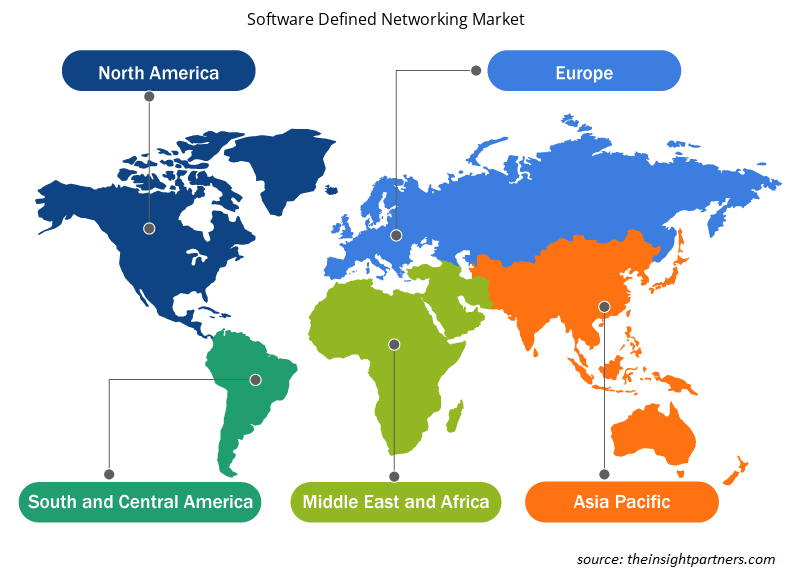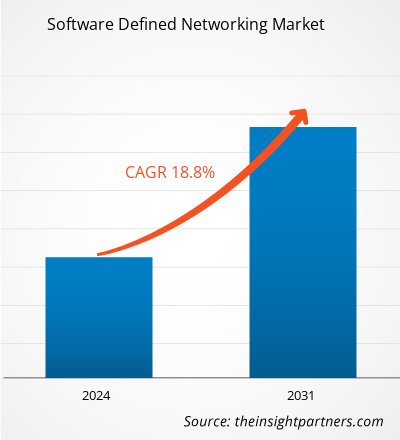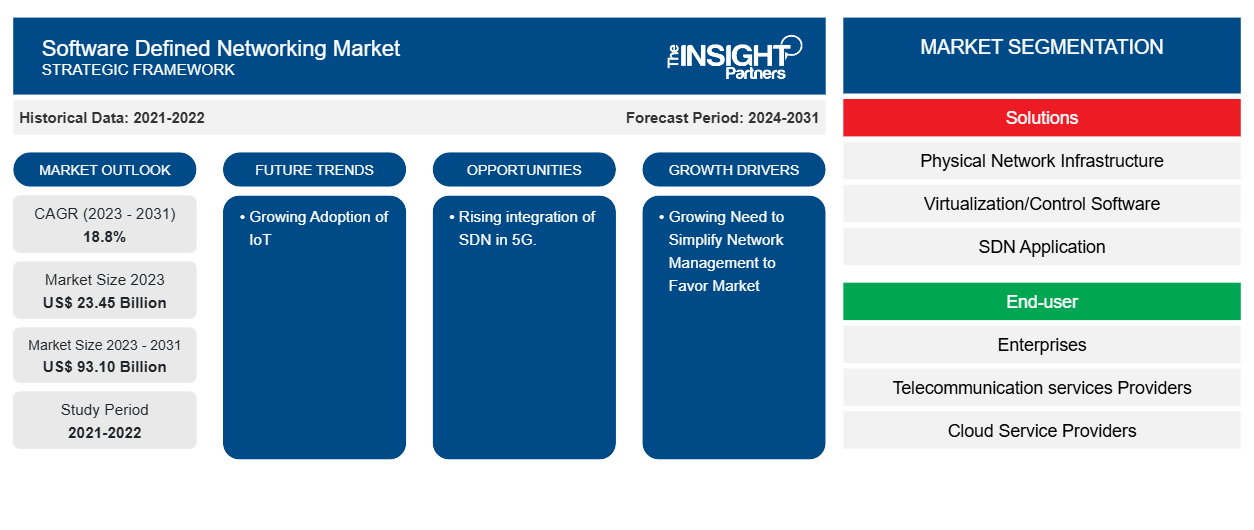软件定义网络市场规模预计将从 2023 年的 234.5 亿美元增至 2031 年的 931 亿美元。预计 2023-2031 年市场复合年增长率将达到 18.8%。简化网络管理的需求日益增长,5G SDN 的实施不断增加,这些可能仍是软件定义网络市场的主要趋势。
软件定义网络市场分析
随着 IT 组织迅速转向云技术,软件定义网络市场正在快速增长并推动市场增长。IT 业务和实体具有与应用程序级角色和事件相关的优势,可提高功能效率和弹性。这包括网络服务自动化、云集成和混合自动化服务。目前,一些企业正在为 SDN 软件生成网络服务应用程序,以便通过使这些服务能够代表应用程序及其可用性对基础设施产生重大影响,从而将虚拟化的价值添加到新标准中。
软件定义网络市场概况
软件定义网络 (SDN) 是一种网络技术,它使用基于软件的控制器或应用程序编程接口 (API) 连接底层硬件基础设施并管理网络上的流量。这种方法不同于使用交换机和路由器等专用硬件组件管理网络流量的传统网络。SDN 可以使用软件来构建和管理虚拟网络或管理传统硬件。
定制此报告以满足您的需求
您可以免费定制任何报告,包括本报告的部分内容、国家级分析、Excel 数据包,以及为初创企业和大学提供优惠和折扣
-
获取此报告的关键市场趋势。这个免费样品将包括数据分析,从市场趋势到估计和预测。
软件定义网络市场驱动因素和机遇
简化网络管理以利于市场发展的需求日益增长
推动软件定义网络 (SDN) 行业发展的主要因素之一是企业对简化网络管理的需求日益增加。传统网络通常具有复杂的设置和手动管理程序,这会增加费用并导致效率低下。SDN 提供用于控制各种网络设备的一致界面,集中网络控制并允许自动化以克服这些困难。这种集中式方法有助于实现供应商中立的方法,加快网络配置,简化策略管理并提高网络性能可见性。SDN 是更新网络基础设施和适应不断变化的业务需求的强大选择,因为它使操作更简单,从而为企业节省金钱、时间和资源。
5G 中 SDN 的融合日益增强。
SDN 是一种符合 5G 生态系统标准的智能网络架构。借助 SDN,5G 可以在控制平面上运行,从而提供完整的框架。数据在5G 网络上传输时的数据流更顺畅,这只是该技术提供的众多优势之一。SDN 架构可减少延迟并最大化网络带宽。通过实时识别最佳数据流,SDN 技术可以从集中控制平面自动化和管理网络冗余,从而避免重大中断。
软件定义网络市场报告细分分析
有助于得出软件定义网络市场分析的关键部分是解决方案、最终用户、部署和垂直行业。
- 根据解决方案,软件定义网络市场分为物理网络基础设施、虚拟化/控制软件、SDN 应用程序和专业服务。
- 根据最终用户,市场分为企业、电信服务提供商和云服务提供商。
- 根据行业垂直,软件定义网络市场分为银行和金融服务和保险、电信和 IT、消费品和零售、政府和国防、制造业、研究和学术界等。
软件定义网络市场份额按地区分析
软件定义网络市场报告的地理范围主要分为五个区域:北美、亚太地区、欧洲、中东和非洲以及南美/南美和中美洲。北美在软件定义网络市场占据主导地位。北美地区各行业的高科技采用趋势推动了软件定义网络市场的增长。包括数字工具采用率的提高和政府机构的高技术支出等因素预计将推动北美软件定义网络市场的增长。此外,美国和加拿大等发达经济体高度重视研发,这迫使北美参与者将技术先进的解决方案引入市场。此外,美国拥有大量软件定义网络市场参与者,他们越来越专注于开发创新解决方案。软件定义网络市场的一些关键参与者包括 IBM、思科和微软等。所有这些因素都促进了该地区软件定义网络市场的增长。
软件定义网络市场区域洞察
Insight Partners 的分析师已详细解释了预测期内影响软件定义网络市场的区域趋势和因素。本节还讨论了北美、欧洲、亚太地区、中东和非洲以及南美和中美洲的软件定义网络市场细分和地理位置。

- 获取软件定义网络市场的区域特定数据
软件定义网络市场报告范围
| 报告属性 | 细节 |
|---|---|
| 2023 年的市场规模 | 234.5亿美元 |
| 2031 年市场规模 | 931亿美元 |
| 全球复合年增长率(2023 - 2031) | 18.8% |
| 史料 | 2021-2022 |
| 预测期 | 2024-2031 |
| 涵盖的领域 |
按解决方案
|
| 覆盖地区和国家 |
北美
|
| 市场领导者和主要公司简介 |
|
软件定义网络市场参与者密度:了解其对业务动态的影响
软件定义网络市场正在快速增长,这得益于终端用户需求的不断增长,而这些需求又源于消费者偏好的不断变化、技术进步以及对产品优势的认识不断提高等因素。随着需求的增加,企业正在扩大其产品范围,进行创新以满足消费者的需求,并利用新兴趋势,从而进一步推动市场增长。
市场参与者密度是指在特定市场或行业内运营的企业或公司的分布情况。它表明相对于给定市场空间的规模或总市场价值,有多少竞争对手(市场参与者)存在于该市场空间中。
在软件定义网络市场运营的主要公司有:
- 思科系统公司
- IBM
- 惠普企业发展有限公司
- 博通
- 瞻博网络公司
- 华为技术有限公司
免责声明:上面列出的公司没有按照任何特定顺序排列。

- 获取软件定义网络市场顶级关键参与者概述
软件定义网络市场新闻和最新发展
软件定义网络市场通过收集一手和二手研究后的定性和定量数据进行评估,其中包括重要的公司出版物、协会数据和数据库。以下是市场发展情况的列表:
- 2023 年 11 月 - VMware, Inc. 宣布推出新的解决方案并扩大合作伙伴关系,以帮助客户加速边缘数字化转型。在最近推出的 VMware Software-Defined Edge 的基础上,这些创新和新集成将帮助客户简化、更好地保护和现代化其边缘环境。
(来源:VMware, Inc.,新闻稿,2023 年)
- 2023 年 2 月,ETSI 开源组织 TeraFlowSDN 宣布发布 TeraFlowSDN 控制器的第 2 版,这是一款创新且强大的 SDN 编排器和控制器。TeraFlowSDN Released 2 为跨多个网络域的端到端传输网络切片提供了扩展且经过验证的支持。此版本完成了 L2/L3VPN 配置、微波网络、XR 光收发器的点对多点集成以及通过开放网络基金会 (ONF) 传输 API (TAPI) 与光 SDN 控制器交互的 SDN 编排。
(来源:ETSI,新闻稿,2022 年)
软件定义网络市场报告范围和交付成果
“软件定义网络市场规模和预测(2021-2031)”报告对以下领域进行了详细的市场分析:
- 范围内所有主要细分市场的全球、区域和国家层面的市场规模和预测
- 市场动态,如驱动因素、限制因素和关键机遇
- 未来主要趋势
- 详细的 PEST/波特五力分析和 SWOT 分析
- 全球和区域市场分析涵盖关键市场趋势、主要参与者、法规和最新市场发展
- 行业格局和竞争分析,涵盖市场集中度、热点图分析、知名参与者和最新发展
- 详细的公司简介
- 历史分析(2 年)、基准年、预测(7 年)及复合年增长率
- PEST和SWOT分析
- 市场规模、价值/数量 - 全球、区域、国家
- 行业和竞争格局
- Excel 数据集
近期报告
相关报告
客户评价
购买理由
- 明智的决策
- 了解市场动态
- 竞争分析
- 客户洞察
- 市场预测
- 风险规避
- 战略规划
- 投资论证
- 识别新兴市场
- 优化营销策略
- 提升运营效率
- 顺应监管趋势























 获取免费样品 - 软件定义网络市场
获取免费样品 - 软件定义网络市场